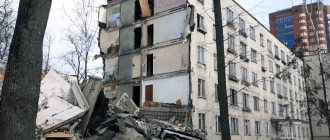Home / Housing disputes / Transfer of residential and non-residential premises / How to transfer an apartment into a residential building
Private house or apartment? This question worries many owners who want to choose comfortable housing. Often there are apartments in a one-story or two-story building. Formally, the building is considered multi-apartment. But by all indications it can be recognized as a private residential building.
The desire of the owners alone is not enough for recognition. In practice, when making a request to the administration, apartment owners are met with a categorical refusal. The question arises, what to do? Obviously, try to transfer the apartment to a residential building through the court. Changing status is a very complex and lengthy procedure. It is important to know the basic steps and stages. Read more about this here.
Is it possible to convert an apartment into a residential building?
An apartment is not a house, and a house is not an apartment. Both concepts refer to housing stock, but there are structural differences. Let's figure out what distinguishes them.
By virtue of paragraph 2 and paragraph 3 of Art. 16 Housing Code:
An apartment is a separate, separate room in an apartment building, consisting of one or more living rooms, as well as auxiliary premises (kitchen, bathroom, toilet, pantry). The building also has common areas - elevators, corridors, staircases, vestibules, etc.
A residential building is a separate, individually defined building, with no more than 3 floors, containing rooms and auxiliary premises - an entrance hall, an attic, an attic. The purpose of a private house is to accommodate one or more families (Article 48 and Article 49 of the Civil Code of the Russian Federation).
It is not always possible to convert an apartment into a residential building. To do this, the building must be located on a plot of land and be considered low-rise. Usually these are 1-2 storey houses on the outskirts of the city.
Expert opinion
Semyon Frolov
Lawyer. 7 years of experience. Specialization: family, inheritance, housing law.
Nowadays in large cities you can find so-called “hybrids” - townhouses. These are houses 2 or 3 floors high with common walls as a connection. There are plots of land nearby - usually up to 2 acres. There may be a garage or outbuilding nearby.
Townhouses have common engineering systems, and each house is equipped with a separate entrance. The area of the objects is guarded; in the local area there may be children's and sports grounds, parking lots, and barriers. Maintenance of townhouses takes place with the participation of utility services - housing office and management companies.
The owners of townhouses register it in the BTI as a “blocked residential building.” Usually no questions arise. And if they do arise, then you can achieve a change of status in court. A similar procedure applies to owners of apartments in old low-rise buildings.
Residential premises can be converted into non-residential premises if there is a desire - our instructions will help you with this.
Transfer of residential premises to non-residential premises
Before converting residential premises to non-residential premises, it is worth considering that you will have to deal with almost all responsible authorities, from the local administration to cadastre service specialists.
- if one or more owners permanently reside in the areas of the territory that is planned to be transferred to non-residential status, there is no permit for registration and residence in the non-residential premises;
- if one of the owners of the premises refuses to provide their consent to the transfer procedure;
- it is impossible to transfer the status of a residential premises to the category of non-residential if the purpose of this procedure is the subsequent implementation of activities of a religious nature;
- it is not possible to carry out the procedure in buildings that belong to the category of social use;
- There is a regulatory ban on the procedure for transferring to non-residential status in relation to areas that have certain encumbrances - secured by loan obligations, rented, under a rental agreement, etc.
12 Jun 2021 uristlaw 197
Share this post
- Related Posts
- What is a Multi-Family House Called?
- Where is the personal account on the water receipt?
- If the Bailiffs Can't Find OOO
- Federal Law on collection activities 2020
Primary requirements
Not every apartment can be turned into a residential building. The owner needs to take into account urban planning regulations.
Technical requirements:
- In order to turn an apartment into a separate house, there should be no common areas (stairs, elevator, corridor).
- Autonomy of communications – we are talking about a centralized engineering system (supply of cold water and hot water, heating, electricity). The ideal option is when each apartment has its own communications and is in no way dependent on its neighbors.
- Separate entrance - no common entrance. You can enter and exit the apartment only through this entrance, bypassing your neighbors in the house.
- Availability of local area . Land under a low-rise building + adjacent plot near the building. Often the land is owned by the city. It does not belong to the residents of the house (at least until the apartment is transferred to the status of private homeownership).
General requirements:
- Consent of all co-owners of the apartment , including minor children. For minors under 14 years of age, consent is given by one of the parents - by virtue of clause 1 of Art. 28 Civil Code of the Russian Federation.
- The residential premises are in the personal or shared ownership of the applicant . For comparison, tenants and tenants cannot change the status of the property. A mandatory document is a certificate of ownership or an extract from the Unified State Register of Real Estate.
- There is no arrest, pledge or other encumbrances. Any restriction is a prohibition to dispose of the apartment, incl. convert it into a residential building. Before the transaction, you will have to lift the arrest, pay off the loan and deal with other encumbrances.
- The residential property is not considered unsafe, at most dilapidated.
Example:
The court considered A. Ivanov’s claim to recognize the apartment as part of a residential building. According to the data, the housing was located in a low-rise building with four apartments. The plaintiff owned one of the apartments; the ownership of the other three was not registered. In fact, it was found that the premises were empty. Their owner was the administration of Novomoskovsk. According to the technical passport, the house has common parts - namely, the roof, attic and foundation. The one-story building also had electricity supply to all apartments. All issues regarding the house were dealt with by the management company - from this we can conclude that the building is at least multi-apartment. The administration of Novomoskovsk filed an objection to Ivanov’s claim.
Based on the case materials, the court did not satisfy the claims. Reason under Art. 16 LC RF and Art. 48 of the Civil Code of the Russian Federation - an apartment building, not a private and residential one. It is also impossible to consider the plaintiff’s apartment as an independent premises. Technically, without renovating the apartment, transfer is impossible.
How to Change the Status of a Residential Building
10. The exercise of the right to re-register the title depends on the will of all co-owners. In accordance with the norms of clause 9.1 of Art. 3 of the Federal Law “On the entry into force of the Land Code of the Russian Federation” and Art. 36 of the Land Code of the Russian Federation, in the procedure for re-registration of title, ownership arises only if all persons who own a land plot with the right of use express their intention to re-register the title of permanent (perpetual) use or lifelong inheritable possession with the right of ownership. To properly consider the case, the courts must take into account that the absence of the will of one of the co-owners of the house to acquire ownership of the land makes it impossible to satisfy the claim. Analysis of legal norms clause 9.1 art. 3 of the Federal Law “On the entry into force of the Land Code of the Russian Federation”, paragraph 3 of Art. 28 “On gardening, market gardening and dacha non-profit associations of citizens”, Art. 25.2 of the Federal Law “On State Registration of Rights to Real Estate and Transactions with It” allows us to come to the conclusion that in the process of re-registration only the title of ownership changes without changing the size of the plot and the number of legal entities, as well as existing encumbrances. In the event that an individual residential building belongs to several persons by right of ownership, the right of permanent (indefinite) use, by virtue of Art. 35 of the Land Code of the Russian Federation and other norms, belongs to all these persons. The exercise of the right to re-register title in this case depends on their common will. This rule follows from the principle of the unity of fate of a land plot and objects firmly associated with it (Article 1 of the Land Code of the Russian Federation). The right of one of the co-owners of the building to re-register the title cannot be exercised independently, since the law does not allow the rest of the co-owners to forcibly grant ownership of the land plot. The will of one of the co-owners in this case is not enough to create ownership rights through a simplified re-registration of title. Accordingly, when considering a claim for recognition of ownership of a land plot, the court must identify all the owners of the building located on the disputed land plot and involve them in participation in the case to clarify their will. The court is not allowed to recognize the ownership right of one of the co-owners of a residential building, since in this case the court actually divides the land plot (if the plaintiff is recognized as the right of sole ownership) or forcibly vests the remaining co-owners of the house with the right of ownership of the land plot (if the plaintiff is recognized as having the right to share in ownership). Thus, by the decision of the Ordzhonikidze District Court of Yekaterinburg, on the claim of G. for recognition of the ownership rights of the plaintiff, ownership of a land plot with an area of 370 square meters was recognized. m, located within the boundaries of the plot ¼ share of a residential building. It is not clear from the operative part of the decision whether the court recognized the plaintiff’s right of sole ownership of the land plot or common shared ownership, determining G.’s share in the right in the amount of ¼.
This is interesting: Debtors City Samara Polevaya 65 C Not Paying Rent
Thus, the Venevsky District Court of the Tula Region considered the case on the claim of Andreeva A.N., acting in the interests of the minor Andreeva P.V., against the administration of the municipal formation Venevsky District, Andreichenko L.A., Tudachkova T.S., Kocherov A.S. on recognition of ownership of a land plot with cadastral number 71:05:030302:407, location: Tula region, Venev, st. Stroitelnaya, 9. classified as land - land of settlements, with permitted use - for the operation and maintenance of part of an individual residential building, with an area of -1262 +/- 12 sq.m., in accordance with the procedure of privatization.
Why convert an apartment to a residential building?
Both a house and an apartment have both pros and cons. Therefore, when re-registering, the advantages of a residential building are usually taken into account. There are undoubtedly more of them:
- Privatization of land. City authorities will not issue permission to privatize the adjacent territory if the applicant lives in an apartment and the house is recognized as an apartment building. Only residential building owners have this right.
- Increasing the area of the house . Due to redevelopment, you can expand the living space compared to a regular apartment. Additional “squares” are useful for creating a study, nursery, wardrobe, second bedroom, recreation room, greenhouse, etc.
- Arrangement of the local area . Near a residential building you can plant flower beds, plant beds, build a gazebo, swings or exercise equipment.
Along with the advantages, there are also some troubles. For example, an increase in utility costs. If the apartments are serviced by a management company, then the owner of the house will have to do this himself. Any failure of the engineering system is his headache.
At the same time, by virtue of paragraph 1 of Art. 389 of the Tax Code of the Russian Federation, the owner will have to pay land tax (rate 0.3 or 1.5%). Of course, if the site is privatized or purchased from the authorities. The amount is calculated from the cadastral value - it turns out to be quite a lot.
How to change the status of a residential building to an apartment building
In 2008, it was not possible to buy a house with a mortgage; it turned out to be unfinished. The house consists of two identical halves of a house on 6 acres with unspecified boundaries of the plot, the second part was sold by advertisement, because... I gave the owner an advance payment - she spent it. Now I can’t change the status of a residential building, make it multi-apartment or block buildings, we have one wall in common.
This is interesting: Will the pension for Chernobyl survivors be increased?
For 35 years the room was used as a separate room. Separate warrants were issued. Now the room is vacant and we are laying claim to it, but according to PIBA documents (old) it is adjacent. I read somewhere that in our situation the room is considered separate. Is it so? And what are the options?
How to transfer an apartment:
Conversion of an apartment into a residential building (part of it) is not provided for by law. But in practice the process occurs. In almost all cases, you will have to act through the courts, since the Moscow Region administration issues a refusal. You cannot do without a trial even if the owner has everything in order with the documents. Thus, both administrative and judicial procedures will have to be observed.
To a residential building
The applicant has the right to transfer the apartment to a residential building if all premises in the building are registered as his property. For example, both living spaces in a semi-detached house. In fact, the owner owns the entire house. But in practice this is not the case, since the documents of the BTI and Rosreestr indicate “low-rise or multi-apartment residential building.” To translate, you need to change this entry to “blocked residential building.” Read on to find out how to do this.
Where to contact?
They begin changing the status of an apartment with a request to the architecture department of the local administration. In almost all cases, redevelopment of the premises is necessary. The catch is that the architecture department does not approve the redevelopment. The services issue a refusal with the note “apartment building”. Hence the logical solution is to address the issue to the local court.
Step-by-step algorithm
Here are instructions on how to convert premises in a semi-detached building into a residential building:
- Agree with the neighbor - the owner of the second apartment (in case the housing is not yet in the status of a residential building). Both owners need to submit a joint application to the administration.
- Order an urban planning examination (for example, by inviting experts from the BTI). The specialist determines whether the owners’ residential premises meet the status of a private home. The expert will mark the external points and issue a technical report. You also need to check if there are any errors in urban planning regulations.
- Third, prepare documents:
- application for transfer of an apartment to a residential building - it is drawn up and signed on the spot (following the sample);
- originals of title documents for apartments (for example, an agreement on privatization, exchange, purchase and sale);
- technical plan of a residential premises or technical passport from the BTI;
- floor plan of a two-apartment residential building;
- a ready-made reconstruction or redevelopment project is not always required, since housing may initially meet the standards.
The list of documents is approximate. The final option depends on the region where the house is located.
- Receive a decision from the municipal administration - positive or negative (with a reason).
The further course of the procedure depends on the verdict of the mayor's office. Most likely they will refuse - then you will have to defend the case through the court (paragraph 7 of article 132 of the Code of Civil Procedure of the Russian Federation).
- Go to court with a statement of claim.
- Receive a court decision in the form of an extract from the decision.
- Contact Rosreestr again and make changes.
Get ready to go to court. The percentage of positive decisions from the administration is low.
Is it possible to convert apartments into housing?
You will need to prepare an application for the provision of a public service for the transfer of non-residential premises to residential premises and submit it to the City Property Department through the MFC or send an application through the State and Municipal Services Portal. If your application is approved, you will receive a decision on whether the non-residential premises will receive residential status. Otherwise, you will be sent a decision to refuse. Then you can go to court to appeal it. Don’t forget to submit an application to Rosreestr through the MFC to make the appropriate changes to the Unified State Register of Real Estate. Only after this the status of the premises will be changed.
Documentedly, this looks simple, but in practice the process can take a long time, since today a large number of apartments are located in multifunctional buildings and do not meet the requirements for residential premises. Yet they were designed and built as non-residential ones.
This is interesting: Where to keep money if they are looking for a bailiff
What is the price?
Given the nature of the procedure, costs appear naturally. But compared to transferring from non-residential premises to residential premises, there is no need to spend money on redevelopment. Typically, an apartment in a low-rise building already corresponds to a residential building.
Co-owners pay for the production of a new registration certificate - about 1,500 rubles . You will also have to order a fresh extract from the Unified State Register of Real Estate. Its cost depends on the copy - a paper one will cost 400 rubles , and an electronic one will cost 250 rubles.
...but this is if the issue is successfully resolved. Going to court means additional costs for paying state fees. A non-property claim for the transfer of an apartment to a residential building will cost 300 rubles (Article 333.19 of the Tax Code of the Russian Federation). Also, expenses for urban planning expertise cannot be excluded.
Change of home status
Moreover, in the cadastral passport the type of permitted use of the land is recorded as “for the construction of multi-storey apartment buildings.” Because of this line, in the cadastral register our house is also written “apartment building”. And because of this line, they refuse to change the word “apartment” in certificates of ownership. And because of this word, the administration refuses to issue certificates of family composition, since the apartments are managed by the management company, and the administration issues certificates only to private owners whose certificates say “share”, “house” or “part of the house”.
From the submitted certificates of ownership for apartments 1, 2, 3, houses No. ... on the street. ...., and the presented floor plan of the technical passport prepared by the Municipal Unitary Enterprise "City Bureau of Technical Inventory" on 06/02/2020 it follows that the residential building in question consists of three apartments.
This is interesting: I have never joined an NPF. Is it necessary to do this in 2020? If I was born in 1985
Registration deadlines
As for the timing, the administration makes a decision within 45 days . It will take about 3 days to notify the applicant. In total, up to 48 days pass from the date of application. about 15 days to register changes in Rosreestr. When applying through the MFC, the period will increase by 2-3 days.
Judicial dates are difficult to predict. The consideration of the case can take 3-4 months, or even six months - depending on the difficulties, additional examinations, counterclaims, failure to appear at meetings, new facts in the case, etc.
Arbitrage practice
The complexity of such cases is that they are poorly regulated by law. There are still no clear criteria for how to transfer an apartment to a residential building without a trial. Hence the huge number of requests from owners for forced re-registration of housing. In fact, the administration of the Moscow Region shifts responsibility to local courts.
However, there is a chance for a positive court decision. Especially if the owners have everything in order with their documents. Courts request construction expert data, this must be taken into account.
Example: Mayskaya A.G. lived in a 3-room apartment located in a two-flat building. The woman believed that her housing met the requirements and submitted a request to the local administration. The goal was to transfer the apartment to part of a residential building. However, the mayor's office refused her, citing the lack of transfer opportunities. Maiskaya filed a lawsuit to recognize the apartment as part of a residential building. She said in the lawsuit that her home is structurally separate, has a separate entrance, there is a nearby area, and free access to the house. The neighboring premises are already in the status of part of a residential building, which allows the plaintiff to make similar claims.
The construction examination established that the residential premises actually belonged to Mayskaya. The apartment has 3 rooms + auxiliary premises (kitchen, hallway, corridor, cold vestibules). The heating in the apartment is autonomous, the sewage system is also separate and serves only the plaintiff’s housing. A separate entrance is equipped according to all standards and complies with SNIP. The court concluded that the apartment meets the characteristics of part of a residential building. The claims for transfer were satisfied in full.
(decision of the Novomoskovsk City Court, 2013)
The legal aspects of transferring apartments into residential households are varied. A problem may be the technical re-equipment of housing, for example, the lack of an entrance, separate communications, or a plot of land. Many people are frightened by the prospect of litigation. We have a solution for this – legal advice. If you are faced with a refusal from the administration, filing a claim, collecting evidence or other difficulties, contact our experts. Together we will solve your problem and tell you how to recognize the apartment as a residential building. Remember that sometimes you simply cannot do without the help of an experienced lawyer!
About what is better, a residential building or an apartment , see below:
Attention!
- Due to frequent changes in legislation, information sometimes becomes outdated faster than we can update it on the website.
- All cases are very individual and depend on many factors. Basic information does not guarantee a solution to your specific problems.
That's why FREE expert consultants work for you around the clock!
- via the form (below), or via online chat
- Call the hotline:
- Moscow and the Region
- St. Petersburg and region
- FREE for a lawyer!

By submitting data you agree to the Consent to PD Processing, PD Processing Policy and User Agreement.
Anonymously
Information about you will not be disclosed
Fast
Fill out the form and a lawyer will contact you within 5 minutes
Tell your friends
Rate ( 1 ratings, average: 5.00 out of 5)
Author of the article
Maxim Privalov
Lawyer. 2 years of experience. I specialize in civil disputes in the field of housing and family law.
Author's rating
Articles written
610
How to Change the Status of a Residential Building
For a “residential building”, compliance with these requirements is not mandatory. However, the practical meaning of this distinction tends to zero, since: - there is no indication that a residential building can only be unsuitable for permanent residence.
At the same time, no distinctions have been made between a “residential building” (according to the Federal Law “On Gardening, Gardening and Dacha Non-Profit Associations of Citizens”) or an “Individual Housing Construction Object” under the Town Planning Code on the one hand, and a “residential building” on the other. However, no definition has been established at all for a “residential building”[2].
12 Jun 2021 uristlaw 892
Share this post
- Related Posts
- What is the Group 3 Disability Pension in 2021
- Changes Made to the Criminal Code of the Russian Federation in 2020
- Housing and communal services debt in St. Petersburg
- How to Get a Place in Kindergarten Without Registration in Yekaterinburg for Nonresidents









